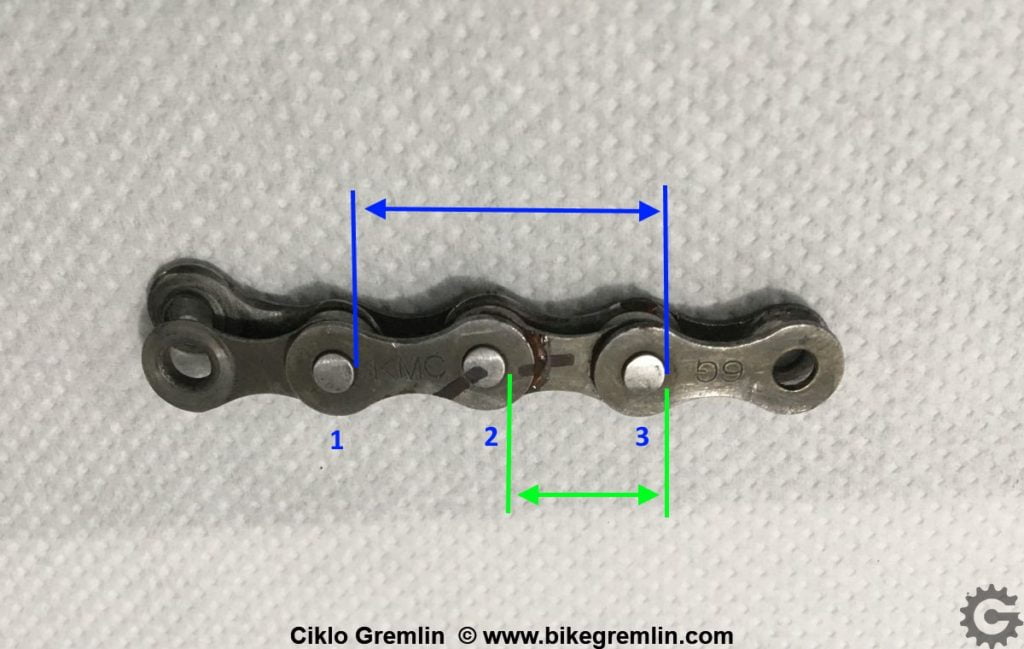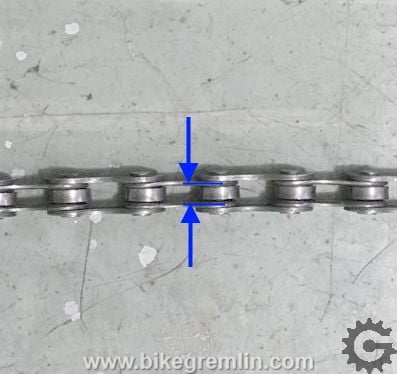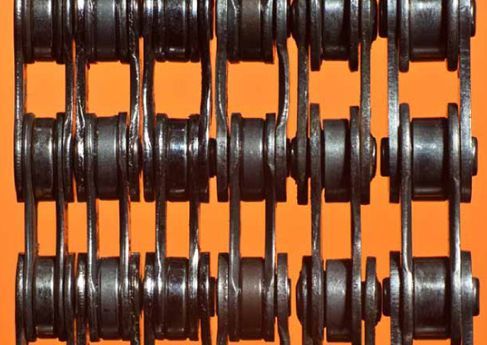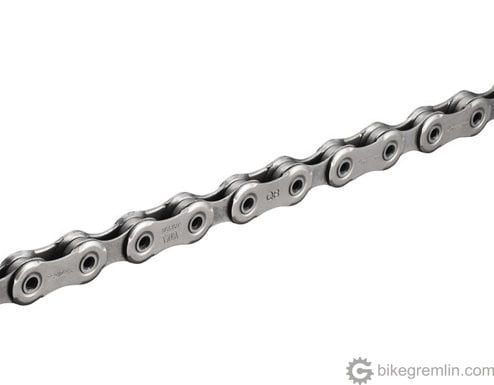This post will give an overview of bicycle driving chains standard dimensions. Each chain has three important dimensions: pitch, inner width and outer width.
TL/DR
If you read this, you will know:
- How long is a bicycle chain link (this is called “chain pitch“)?
- How do chain inner widths differ depending on the number of speeds (why do the high-speed narrow chains get stuck on single speed wide chainrings)?
- How do chain outer widths differ (why do low-speed wide chains get stuck between high-speed narrowly spaced cassette sprockets)?
I’ve also added a chain width table.
1. Bicycle driving chain pitch
Chain pitch is the distance at which the pins are placed. It is measured by measuring the distance between 3 links, then dividing it by two.

Picture 1
For detailed explanation of chain pitch, and why measuring three pins gives a more accurate result read the post Chain wear (“stretching”). For this post it suffices to say that bicycle chain pitch is exactly 1/2 inch (12.7 mm). This goes for all the bicycle chains, regardless of the speed number.
2. Chain inner width
Inner chain width is the spacing between a pair of inner plates. It is marked in the picture 2.

Picture 2
For inner chain width there are the following standard dimensions:
- Single speed chains have inner width of 1/8″ (3.175 mm).
- Multi speed chains, from 5 to 8 have inner width of 3/32″ (2.38 mm).
- Multi speed chains from 9 to 12 speeds have inner width of 11/128″ (2.18 mm).
- “Exotic” standard for freight bicycles is 5/32″ (4 mm).
3. Chain outer width
Chains for one and multiple speeds differ from each other by the outer width. The more “speeds” a chain is designed for, the thinner the outer plates and shorter the pins are (and they protrude less) – so the outer chain width is smaller (i.e. chain is narrower). Inner width of all the multi speed chains is almost the same – with only single speed chains having a significantly larger inner width.

Campagnolo 11 speed, SRAM 10 speed, Shimano 9 sp, SRAM 6/7/8 sp, old 5 speed, 1/8″ single speed chain
Picture 3
Note how rollers of all the multispeed chains are of almost the same width, only single speed chain being significantly wider on the inside.
Pitch is the same for all the chains – they are aligned by length.
As can be seen from the picture 3, the outer width differs mostly. This is important for bikes with multiple sprockets, so the chain doesn’t get stuck (too wide), or drop between the sprockets (too narrow – this latter case is practically never a problem in practice).
See this great post by “Graeme_FK” on the Cycle Chat forum for an in-detail explanation of the “fine print” in terms of Campagnolo vs Shimano vs SRAM vs 1x chain compatibility and size differences.
3.1. Bicycle chain width standards table
Table 1 gives an overview of chain outer dimensions, by number of speeds.
| Number of sprockets (speeds) a chain is designed for | Chain’s outer width in mm |
|---|---|
| All 6 speed | 7.8 |
| All 7 speed | 7.3 |
| All 8 speed | 7 ~ 7.3 * |
| All 9 speed | 6.5 – 6.7 |
| 10 speed old Campagnolo standard | 6.2 |
| All other 10 speed | 5.84 – 6.1 |
| All 11 speed | 5.46 – 5.74 ** |
| SRAM 12 speed MTB | 5.25 |
| Shimano 12 speed MTB | n/a |
| Campagnolo 12 speed | 5.15 |
| Campagnolo Ekar 1×13 speed | 4.9 |
| Rotor 1×13 | Uses SRAM 12-speed MTB chain standard |
** See the two comments by Klaus here (thanks for the valuable feedback),
until I double check and confirm.
4. Bicycle “chain construction and standards” video
My video explaining bicycle chain construction and dimension standards:
For an overview of which chains can be combined with which sprockets, read this post: Bicycle chains compatibility:

The existing comments posted under this article (questions and answers) have been moved to this BikeGremlin forum thread:
https://www.bikegremlin.net/threads/bicycle-drive-chain-standard-dimensions-article-comments.122/
Last updated:
Originally published:


Any updates on 12 speed chain dimensions, specifically 12 speed Campagnolo vs KMC 12 speed Missing Link and SRAM 12 speed Power Link?
I just ordered a 12 speed Campagnolo group, and since I need to separate my chain quasi frequently to wax it, I want solution other than riveting Campagnolo pins.
Still haven’t got any reliable data. No 12 speed drivetrains in my shop so far. 🙁
Will have to ask trusted fellow mechanics for measurements and will carry a precise vernier caliper on my next travel abroad and use the occasion and double check.
Only Shimano 12 speed is available in some shops here – didn’t see SRAM, or Campagnolo – Campagnolo is sort of a cycling unicorn in Serbia: everyone knows it’s cool and nice, but (almost) no one has seen it. 🙂
For the purpose of Narrow Wide drivetrains, should more consideration to the width between the inside edges of the “outer plates” be noted? Most Narrow Wide Chainrings state compatibility with 9-11 or 12 speeds. I assume that the “wide” (which I take to mean “thick”) tooth profile fits inside of the “outer plates.” Perhaps these chainrings are not compatible with 8 speed chains because the rings do not fully fill the gap in such chains. Less likely, the “narrow” tooth of such a NW chainring may be 11/128″ thick instead of 1/8″ again not filling the gap between (this time between the inner plates) even if those don’t vary by much. Failure to fully fill either gap may result in failure to retain the chain, thus incompatibility.
Correcting error: meant to say 3/32″ where I wrote 1/8″. Apologies.
It makes sense – narrow wide chainrings only come in even tooth counts (no odd ones), for exactly the reason that it’s the only way to make sure that wide teeth always go between the wider (outer) chain plates, and narrow teeth between the narrower (inner) chain plates.
I would expect 8 (and fewer) speed chains (with 3/32″ i.e. 2.38 mm inner width) to be a less tight fit on those chainring teeth, designed for 9+ speed chains (with 1/128″ i.e. 2.18 mm inner width).
Unfortunately I haven’t had much experience with the modern 1x drivetrains. Probably will in a few years, as more and more people get that stuff 2nd hand from Germany and the likes. The very thing that made me experiment and document compatibility – a constant lack of “proper” components availability – is what makes it difficult for me to test the newest stuff as it comes out to the market. And the fact I make sure to note all the downsides, and call out any marketing gimmicks I notice, makes me believe that it’s not very likely for the manufacturers to be sending me samples for testing, as they do with some other websites/companies. 🙂
So I haven’t made any measurements, or experiments with 1x drivetrains yet. I have found an article that does show a few types and different 1x solutions, though without considering compatibility at all, but it’s a start:
https://www.garbaruk.com/blog/articles-1/post/the-state-of-narrow-wide-chainrings-1
Relja, many thanks for the careful, meticulous and informative work you do in helping us understand the somewhat obscure details of the bicycle industry. in the spirit of constructively and cooperatively helpful assistance, i refer to your Update of 05 Jan ’21, where you note, “Each chain has three important dimensions: pitch, inner diameter and outer diameter.”
First let me say that your command of my first (and only) language is way, way better than any grasp i might have of what is probably *your* first language.
then, i think when you say ‘diameter’ here, you are referring to ‘width’. in english when we say *diameter*, we are referring to the distance across a circle, on a straight line across the center. so unless you are referring to the inner and outer diameter of the chain *roller*, which is circular, the word ‘width’ makes more sense in this context. just trying to be helpful. again, thanks for your public-spirited work.
Hello Chris,
Thank you very much for noticing the mistake and taking the time to let me know. I’ve edited the text right away.
The mistake you noted is not a simple, obvious, spelling one, hence it is more “dangerous” – for it could make the reader draw a wrong conclusion.
I do 99.9 % of both writing and editing myself, so the support and corrections I got from the community over the years have been of huge help.
glad to have been of assistance.
i must say, reading your analysis has led me to change my thinking about multi-speed chains & cassettes. there is a persistent folklore in the bike world that 12, 11, and 10-speed systems have a shorter component life (chains & cogs, when operating conditions are identical) than 5, 6 & 7-speed systems (for example), due to presumably smaller surface areas of contact between teeth & chain rollers (narrower, we assume, when there are more cogs). however, if it is in fact true that roller width (& therefore cog width) is the same for all systems, then there is no reduction in durability of systems with higher numbers of speeds?
The short answer is:
I don’t know.
Longer one:
I’m not 100% sure.
Even longer, with an explanation:
When doing experiments and comparisons, it is very difficult to draw a correct conclusion when more than one thing is altered.
With bicycle drivetrains:
1) Chains
5 to 8 speed chain inner width is narrower than it is for single speed chains.
9+ speed chains are a bit further narrower.
2) Cassettes
Cassette sprockets are practically narrower for each extra gear added (two adjacent numbers of gears sometimes have the same sprocket thickness, like Shimano 10, and 11-speed cassette sprockets both being 1.6 mm thick).
3) Drivetrains
Modern drivetrains often have only 2 front chainrings, or even only 1, and cross chaining is more exaggerated with the modern systems (50-34 compact doubles, or 1x systems). Higher amount of cross-chaining would affect drivetrain durability even if all else were equal – but it’s not, depending on the number of gears, gearing configuration etc.
4) Manufacturing quality
I’ve run comparison tests with 8 speed chains. Primitive, no lab. Just using one same bicycle (mine), same drivetrain (tooth count, cassette and cranks model etc.), same maintenance schedule, and the same riding conditions as much as that can be achieved without a lab. There’s a huge difference in chain life with different models, even from the same manufacturer.
I can’t test 1000 chains, to have statistically valid and reliable data, so I take my own results with a grain of salt. But, when I test the same model twice, and it lasts twice as long compared to another model I’ve also tested only twice, I do believe it is correct to conclude that it is longer lasting. Perhaps not double, not exactly, but to roughly conclude it is better is a conclusion I’m satisfied with.
I have also put a high-end 10-speed chain for a test, on that same drivetrain. To compare how long it lasts compared with the previously tested 8 speed chains, using the same cassette sprocket and crank chainring thickness. If health and luck serve me well, I’ll have results by the end of this year (almost got run over this Friday, on the way to work – careless driver – so I shouldn’t underestimate luck! 🙂 ).
After testing the 10-speed chain on a 7-speed cassette, I plan to re-do the test using a 10 speed cassette (friction shifters make playing with different setups very simple 🙂 ).
Thanks to that, I’ll also be able to test an 8-speed chain on 10 speed cassette sprockets (just running fewer of those, and using some wider spacers).
5) Chain nemesis
My theory is that dirt is the nemesis of chains. All the modern chains, from 7 to 12 speeds have no mechanism of keeping the lubricant inside, and dirt out. The bushings were cast out for lower weight, cheaper manufacturing, and easier severe cross-chaining.
On that account, on my motorcycle, cam timing chain (is that the right term – the chain inside the engine block) is half as thick compared to the drive chain, yet it lasts about 10 times longer. After having installed Scottoiler chain lubricant – that drips low viscosity lubricant over the chain practically constantly, and that swings off the chain along with the dirt, my drive chain lifetime had gone up by at least 3 times, compared to cleaning and lubing it with thicker lubricant on a regular basis.
Doing something like that with bicycles is not very practical – for me at least. So I choose to just run with the cheaper stuff. Decent quality chains seem to last approximately the same, regardless of the number of speeds. However, that’s just my subjective impression, so I’ve decided to run a sort of a primitive test to see if that’s at least roughly correct.
The article was great. Can you shed some light on how to clean and lube a chain. On a single speed bike would a master link be better. so you could take the chain off to clean and lube it. Thanks vince
Hi Vince,
I already wrote in great detail about various different chain cleaning methods, their pros and cons.
You can read it and decide for yourself, what works best for you:
Bicycle chain cleaning and lubricating.
Relja